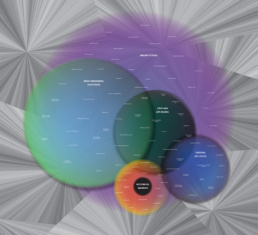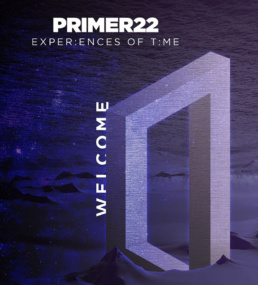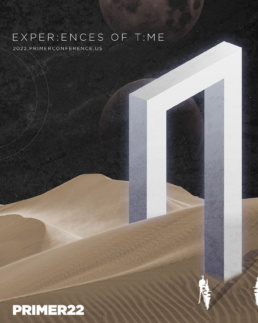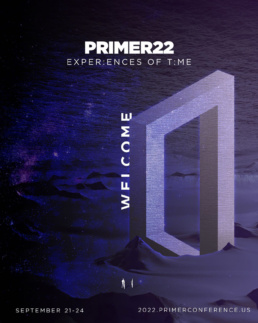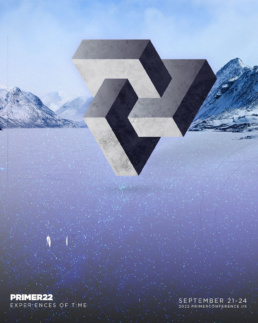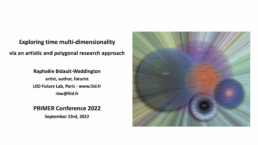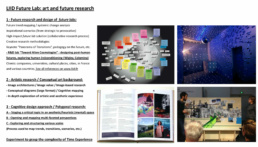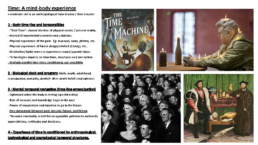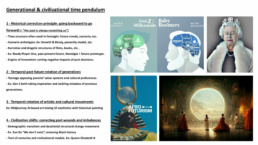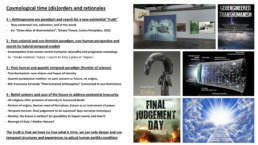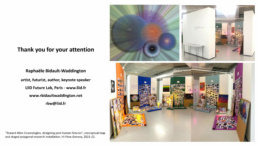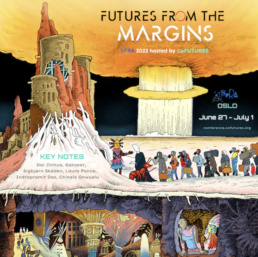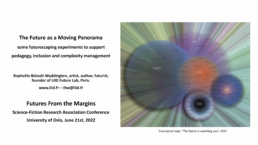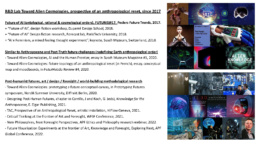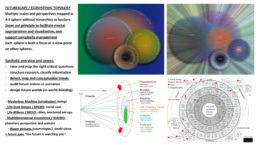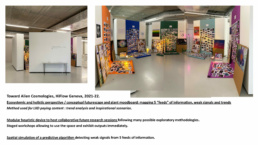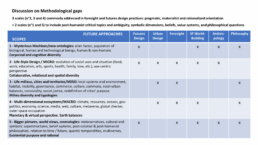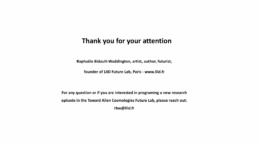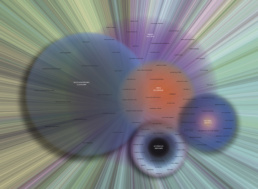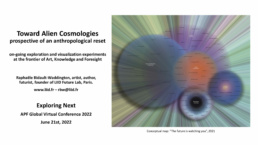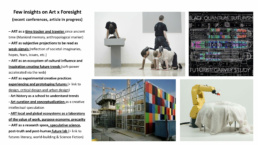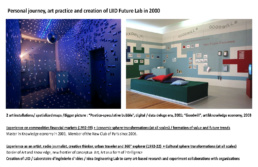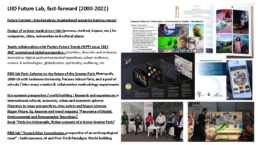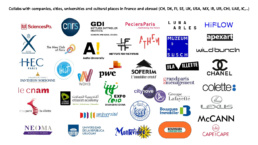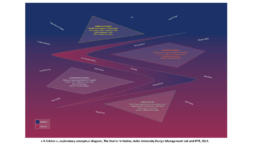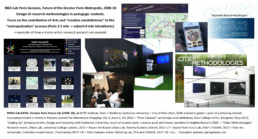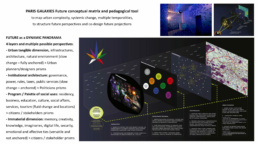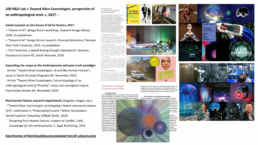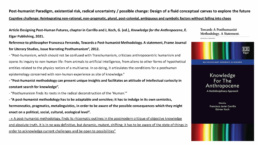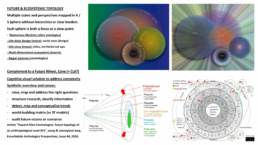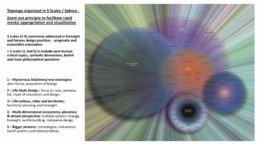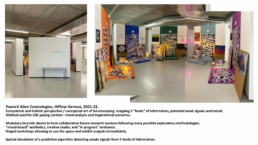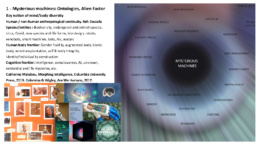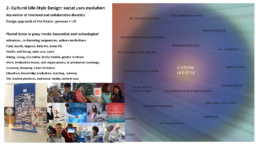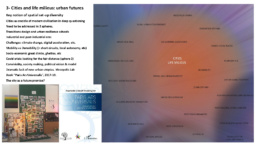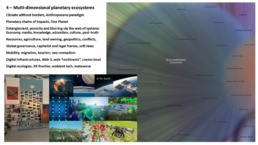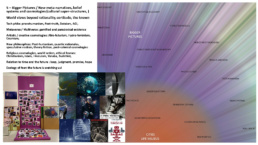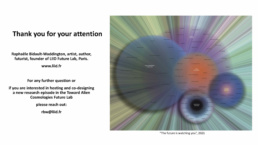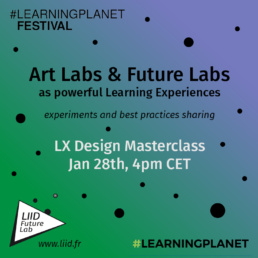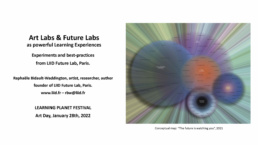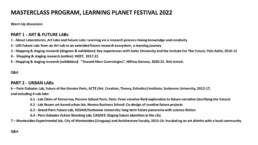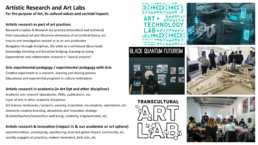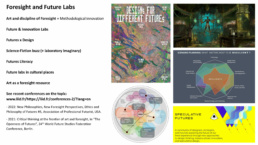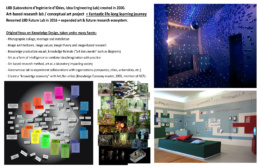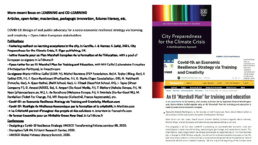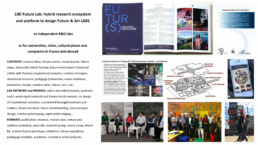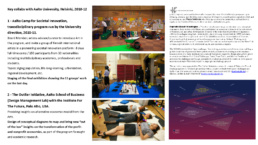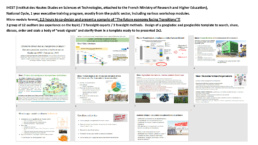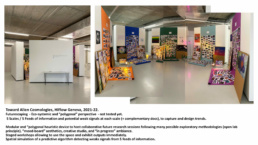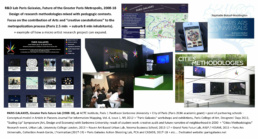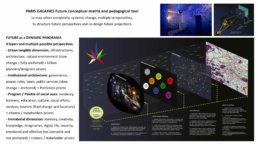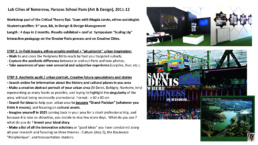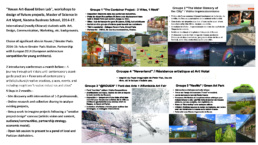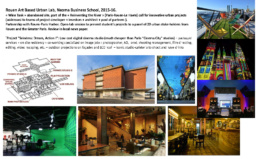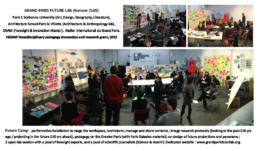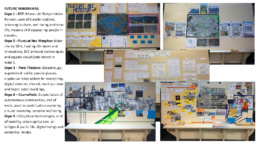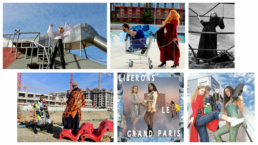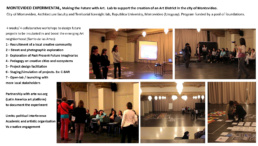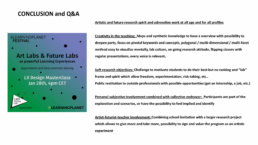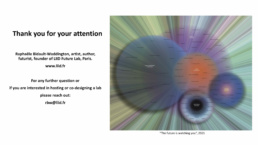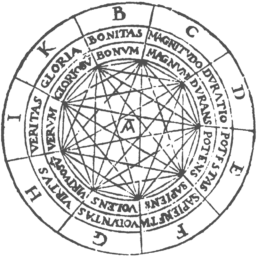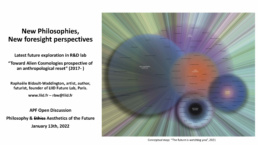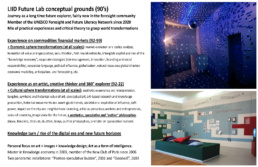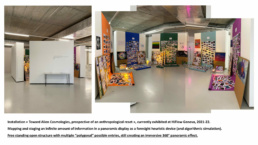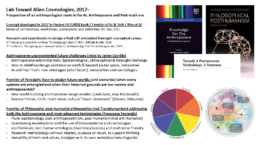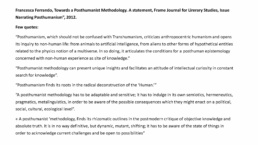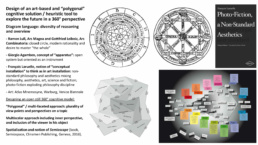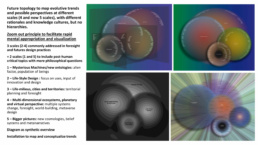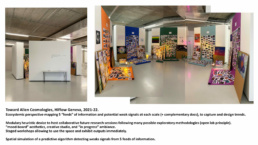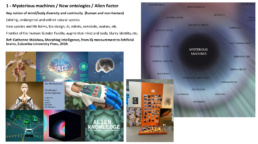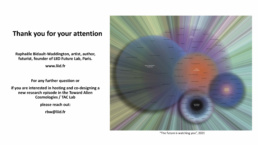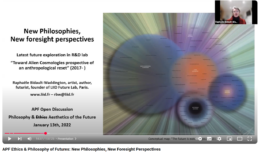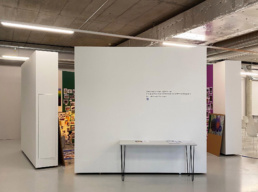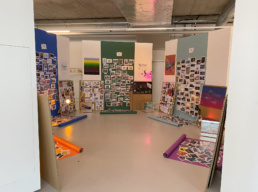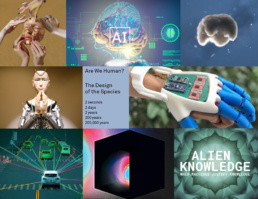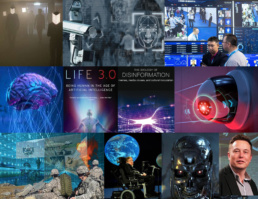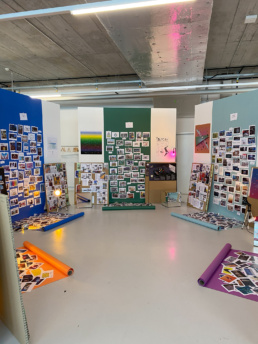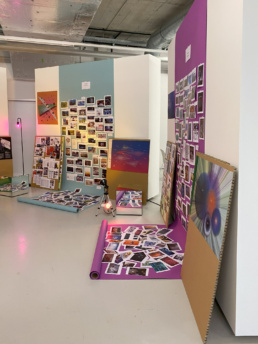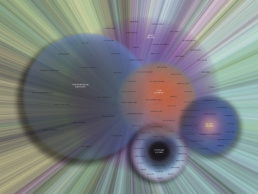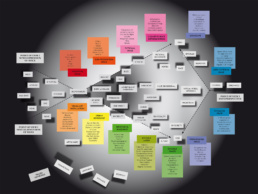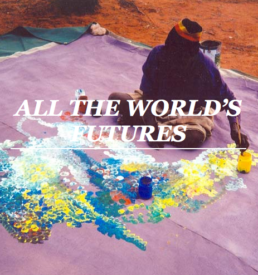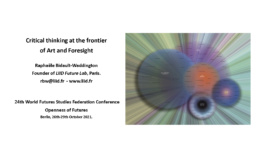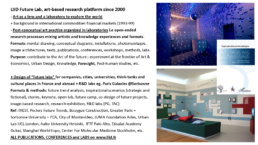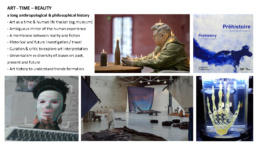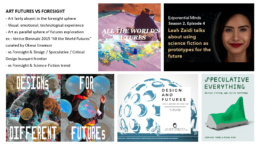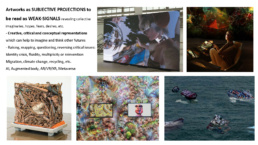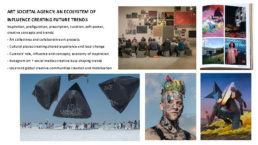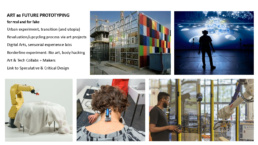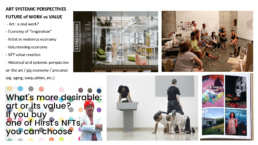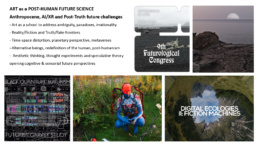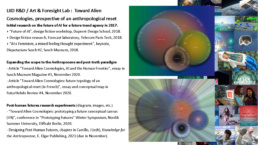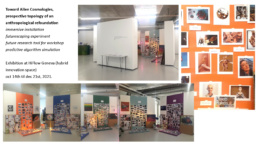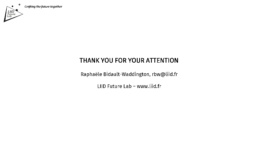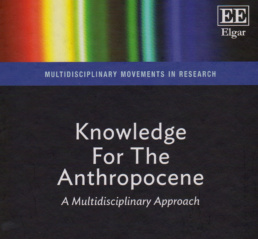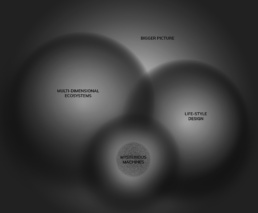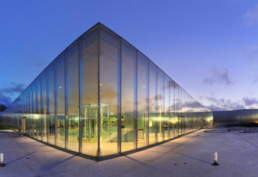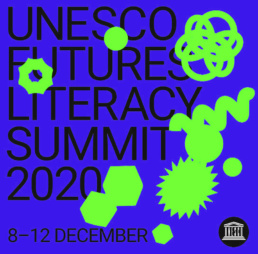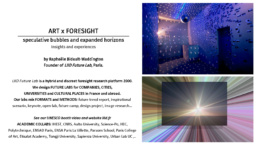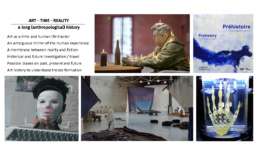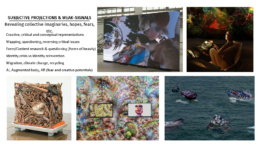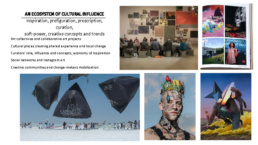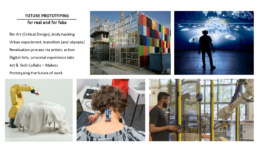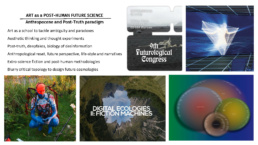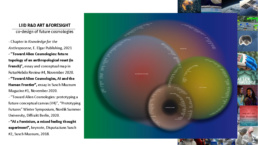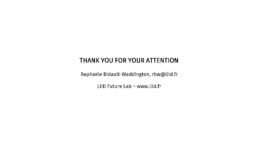Anticipated Worlds Festival, Cité of Sciences, Paris, 2022
Science Fiction and Metaverse
speculative conversation and exhibition
Festival des Mondes Anticipés, Cité des Sciences et de l’Industrie, Paris, 2022.
In this future-oriented festival, a new and large-scale version of the TAC Future Canvas was exhibited and became this time a rich panorama of creative concepts and future trends positioned on the five spheres, as inspirational signals of the future. In this context, the aim wass to invite the viewer to conduct their own imaginary investigation, in search of future worlds...-
In parallel to the exhibition, Raphaële Bidault-Waddington took part in a speculative discussion on metaverses following the projection of Ready Player One (Spielberg), a film that stages and shows the tensions between real, future, virtual and fictional worlds – a question she investigated in her article on this film published in the same period.
A propos du Festival
Pour sa première édition, le Festival des Mondes Anticipés explorera le thème « Il faut sauver le vaisseau Terre » grâce à diverses animations dont la projection de 4 films d’anticipation. Ceux-ci seront suivis d’échanges entre les spectateurs et des invités à partir de la question « Si le scénario du film advient, quelles en seraient les conséquences pour les individus et les organisations humaines ? ». Chaque projection sera précédée d’une conférence indépendante qui, elle aussi, explorera le thème de la saison.
Autour de la salle, les visiteurs pourront découvrir une exposition qui présentera les visions positives du thème de l’année proposées par des artistes (la dystopie est laissée au cinéma !). Ils découvriront également des œuvres (romans, BD, courts métrages, projets d’urbanisme/architecture).
En plus d’être accueillis par la Cité des sciences et de l’industrie, les Mondes Anticipés sont soutenus par le Ministère de l’enseignement supérieur, de la recherche et de l’innovation, par l’Institut des hautes études pour la science et la technologie, et Space’ibles, l’observatoire de prospective spatiale du CNES qui participe à la programmation du festival.
Cartel de l’œuvre
« Vers des Cosmologies Alien, prospective d’une refondation anthropologique », 250 x 280 cm.
de Raphaële Bidault-Waddington, artiste, auteure, prospectiviste, LIID Future Lab.
Vers des Cosmologies Alien est le laboratoire de R&D artistique et prospective développé par Raphaële Bidault-Waddington depuis 2017 afin d’adresser les grands défis planétaires qui secouent tous nos fondements anthropologiques.
L’ère de l’Anthropocène et la prise en compte de l’environnement montre combien les usages de société et les modes de vie hérités de l’ère industrielle, ne sont pas durables et doivent évoluer vers de nouveaux modèles d’habitabilité, sur Terre ou ailleurs, qu’il reste à inventer. De même l’avancée des technologies susceptibles d’augmenter l’humain comme de développer de nouvelles formes de vie, de corporéités, d’intelligence voire de conscience, obligent à reconsidérer ce que veut dire être humain, cet alien parmi les autres. Ceci convoque de nouvelles visions et ordonnancements conceptuels du monde, ce que les anthropologues appellent des cosmologies.
L’ampleur et la complexité des questions posées, requiert d’explorer de nouvelle manière de produire des connaissances qui transcendent les segmentations, logiques et disciplines, celles-ci étant souvent trop ancrées dans l’héritage rationaliste occidental. L’art est à ce titre une véritable ressource permettant à la fois d’ouvrir de nouvelles perspectives, intuitions ou raisonnements, comme de resynthétiser des vues d’ensemble.
Cette cartographie artistique, structurée en cinq sphères flottantes, entrelacées et non-hiérarchisées, est ainsi l’un des outils heuristiques du laboratoire, et permet de construire mentalement par l’imagination de possibles visions du monde et de l’avenir. Elle sert de canevas pour aussi bien cartographier des tendances ou scénarios prospectifs, que pour façonner ou analyser des univers futurs, qu’ils soient issus de la prospective ou de la science-fiction.
Discussion spéculative autour de Ready Player One (Spielberg, 2017)
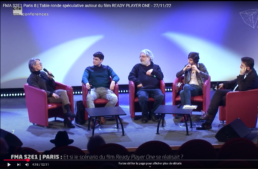
Modérateur : Thibault Renard, Cybercercle
Intervenants : Raphaële Bidault-Waddington, artiste et prospectiviste ; Camille Rouge, fonctionnaire ; Rémi Sussan, journaliste ; Sylvain Cavalier, youtubeur.
Voir la vidéo sur Youtube
Research axes reminder
Axis 1: Transitions & Future Worlds
Axis 2: Foresight Methodology Innovation
Axis 3: Art & Future Research
Related articles
Nothing found.
Artistic & Polygonal Research on Time multidimensionality, PRIMER, 2022
Exploring time multidimensionality
via an artistic and polygonal research
PRIMER 2022 Global Conference, online, 2022
Continuing our reflections on Art and the Future (Axis 3), here we conduct an experiment to deepen the question of Time and the evolution of temporal architectures in light of the current change in the world – such as the Anthropocene requiring to envision long term perspectives.-
The body and the human condition inscribe us in certain realities and temporal structures that are not necessarily immutable or universal. Space and cognitive diversity (post-colonial cosmologies), ubiquitous and virtual technologies, and scientific advances all impact our temporal frameworks, schemes, and representations.
-
Connected to our deepest beliefs, and especially those concerning the future, the experience of Time proves to be multi-dimensional, ambivalent, and infinite. These reflections open up avenues for imagining future cosmologies.
Abstract
Time is a deeply multi-dimensional, complex and paradoxical experience. On one hand, our senses are able to experience several parallel or entangled forms of time, through events progression inside the real time, whether in the physical environment, in vehicles, via sound, screens and technological devices, images, windows or the distant landscape.
On another hand, and simultaneously or not, our mind is also capable of disrupting the timeline to travel backward and forward, in various dimensions (history, fiction, metaverse, immaterial, cosmos, future, etc.), and thus generating other time shapes and more dynamic time experiences.
Using images, artworks and theoretical concepts from different fields (philosophy, aesthetics, musicology, urban design, etc.), we propose to draw a taxonomy of time shapes and experiences, via a multi-faceted and diagrammatic approach (polygonal research).
RBW
Intervention slides
About PRIMER 2022 Conference
PRIMER, the conference designed to prepare you for the future
In 2022, PRIMER seeks to explore a theme as old as philosophy: we want to share perceptions, experiences, and current state-of-the-art futures practices to look deep, wide, and far into what might soon become the next paradigms.
Experiences of Time
In an era of growing parallelisms and of age-old notions yearning to be redefined, we are brimming on a nexus where our individual and collective consciousness and our presences are increasingly manifesting in – and through – hybrid experiences.
It is certainly a defining time, one of those “perfect storms” in which we can proactively apply our speculative competences to the many challenges ahead envisioning futures with full awareness, with a sense of urgency, or doom. Or, simply, with inertia.
Our theme this year focuses on the experience of time.
Conference program on Instagram
Research axes reminder
Axis 1: Transitions & Future Worlds
Axis 2: Foresight Methodology Innovation
Axis 3: Art & Future Research
Related articles
Nothing found.
The Future as a moving panorama, Sci-Fi Research Association, University of Oslo, 2022
The Future as a Moving Panorama
Introducing a Futurescaping Canvas to Support Pedagogy, Inclusion and Complexity
in Futures From the Margins, Science-Fiction Research Association International Conference, University of Oslo, 2022.
This intervention highlighted the pedagogical benefits of the TAC Future Canvas to explore and design future worlds in an open, plural, intuitive and inclusive way. Stemming from artistic and prospective reflections, it was designed to facilitate the mental representation and structuring of the future, seen as a prospective panorama (futurescape) and as a multi-dimensional and moving ecosystem.-
It helped to lighten the complexity of prospective exploration, enriched the range of its tools, whether to organize research or to produce future visions, and showed affinities with Science Fiction creations of cosmologies and practice of world-building. But rather than proposing and staging a specific future world, the canvas supported the diversity of perspective and the possibility to consider and situate many viewpoints, in order to venture into the margins, open up potentialities and better include.

Abstract
“Toward Alien Cosmologies, prospective of an anthropological reset” is an on-going art-based future lab initiated by LIID Future Lab in 2017 to explore radically new ways of creating and questioning futures in the Anthropocene, AI and Post-truth era. This unprecedented paradigm shift is shaking all our anthropological grounds (human condition, relation to nature, time and space, values and belief systems, etc.) and requires to emancipate from western anthropo-centrism, materialism and epistemological frames, which still dominate conventional foresight practices. Post-humanist and non-western philosophies are important cognitive resources in that regard, but also art and aesthetics to liberate imagination, adventure into more free-style cognitive paths, and generate ex-centric future vocabularies at the periphery of dominant futures.
Through iterative research, the lab developed a fluid and non-hierarchal conceptual canvas to design or appreciate, individually or collectively, future worlds or rather “cosmologies”. These stand as borderless, hybrid (real, virtual and fictional) future universes where alternative rationalities, life-styles, hybrid ecosystems and modes of existence can be designed as speculative experiments.
In these future and more-than-human cosmologies, the alien is as much the human who needs to reinvent sustainable ways of living on Earth, as AIs’ mysterious black-boxes, avatars, non-humans, viruses and other strange species fashioned by bio-engineers, and more generally the unknown and the future. How to live in the future and make a society with the alien factor?
For the conference, we will introduce the canvas, which works as a “polygonal” critical topology.
RBW
Option (if additional time or space): we will perform a narrative system of five entangled stories created with the canvas, to prototype and simulate a first and most likely dysfunctional future cosmology. These stories are narrated along a visual demonstration made of artistic photomontages but also include real-life characters, places or stakeholders. Instead of falling into radically alternate worlds or science-fiction aesthetics (where world-building approaches often lead), the experience searches to play with the ambiguity between reality and fiction, and with the make belief mechanisms at the heart of our relation to the future. The stories will also include a theoretical dimension, half way between philosophical tales of the future and theory-fiction experiments, in order to touch on and relate key critical future topics in an un-orthodox way. As far as now, we have no clue of where that will lead us…
Intervention slides
About 'Futures from the Margins' Conference
What do futures look like from the margins? The 2022 SFRA Conference is dedicated to visions of human futures that center and foreground the issues of those from the margins, including Indigenous groups, ethnic, religious, and sexual minorities, and any people whose stakes in the global order of envisioning futures are generally constrained due to the mechanics of our contemporary world. For many people around the world imagining radically different futures has a life or death quality, as their presents are beset by societal discrimination, poverty, inequality, and precarity, as well as the acute effects of climate change and the global environmental crisis. How can futures from the margins speak to power in presents?
We are especially interested in contemporary “futurisms” that foreground the margins, expose market processes in manufacturing majoritarian futures. Possible topics include but are not limited to:
• Speculation and Demanding the impossible
• Theories of contemporary futurisms
• Indigenous Sciences and speculative worldbuilding
• Neo-colonialism and speculative futures
• Worldbuilding the Otherwise
• Climate change and futures from the margins
• Critical dystopias in climate change thinking
• Pleasure Activism and Speculative Thinking
• New philosophies of time in futurisms
• Resistance and politics of hope
• Cofuturisms
Site et programme de la conférence : conference.cofutures.org/2022-conference/
Research axes reminder
Axis 1: Transitions & Future Worlds
Axis 2: Foresight Methodology Innovation
Axis 3: Art & Future Research
Related articles
Nothing found.
Future visualization experiments, Exploring Next, Association of Professional Futurists, 2022
TAC, prospective of an anthropological reset
on-going exploration and visualization experiments at the frontier of Art, Knowledge and Foresight
Exploring Next, APF (Association of Professional Futurists) Global Conference (online), 2022.
Recalling the many bridges between artistic research and foresight, the intervention traced how the design of the TAC Future Canvas continues from LIID future Lab’s previous work and from Raphaële Bidault-Waddington's artistic practices (Image Lab, Polygon installation, Sémioscape diagram).-
The TAC Future Canvas was then unfolded along its 5 spheres / scales of transformation and projection of the world towards the future. Each is impacted by numerous trends and illustrated with moodboards. The artistic installation exhibited at HiFlow at the same time gave an even broader overview of the five dimensions.
-
The creation of diagrams presents formal (visuality, overall mapping, sensitive report), conceptual (methodology, reasoning structure, ordering, pedagogical clarity), and prospective (change mapping, ecosystem vision, multiple perspectives) advantages.

Presentation
APF, Association of Professional Futurists, in pleased to announce its first fully online global conference.
𝐸𝑥𝑝𝑙𝑜𝑟𝑒 𝑁𝑒𝑥𝑡. . . 𝑇ℎ𝑒 𝐹𝑢𝑡𝑢𝑟𝑒𝑠 𝑜𝑓 𝐻𝑢𝑚𝑎𝑛 𝐸𝑥𝑝𝑒𝑟𝑖𝑒𝑛𝑐𝑒: 𝑃𝑒𝑜𝑝𝑙𝑒, 𝑃𝑙𝑎𝑐𝑒𝑠, 𝑆𝑦𝑠𝑡𝑒𝑚𝑠, 𝑎𝑛𝑑 𝑇ℎ𝑖𝑛𝑔𝑠
From how and where people are living to the systems and things that are shaping our modern world, Explore Next brings together top world-class futurists and industry leaders to explore experiences that you may expect in the near-term, mid-term, and long-term futures.
With topics ranging from next-generation cities and the future of food to cyber security and transhumanism, this conference will feature keynotes, workshops, panel discussions, field trips, and networking events.
𝙎𝙤𝙢𝙚𝙩𝙝𝙞𝙣𝙜 𝙛𝙤𝙧 𝙀𝙫𝙚𝙧𝙮 𝙏𝙞𝙢𝙚 𝙕𝙤𝙣𝙚
With speakers on 6 continents, this conference offers presentations for 3 regions over 8 non-consecutive days.!
Parallel Streams
Select your favourits sessions out of three different streams, running in parallel:
1. SAGE = Keynotes, Presentations,
2. EXPLORER = Workshops, Interactive,
3. REBEL = Get Suprised, Broaden your Mindset
Intervention slides
Research axes reminder
Axis 1: Transitions & Future Worlds
Axis 2: Foresight Methodology Innovation
Axis 3: Art & Future Research
Related articles
Nothing found.
Art & Future Labs as LX, Learning Planet Festival, 2022
Art & Future Labs as Powerful Learning Experience (LX)
Experience sharing
Online masterclass, Learning Planet Festival, Learning Planet Institute, 2022.
During this interactive masterclass, RBW presented the educational aspects of her artistic, urban and prospective research laboratories, and showed how this type of exploratory practices, and more generally the 'lab culture', can be learning accelerators.-
The revaluation of this aspect of her experiences is part of a broader reflection on the role of training as a key lever for transitions and the making of the future, as well as on the future of learning in and outside the academic sphere.
-
The masterclass was organized in partnership with the LX Design MeetUp group, which fosters exchanges of best-practices between learning innovators in non-academic and inclusive contexts.
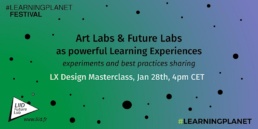
Webinar presentation on eventbrite
During this 90mn masterclass, Raphaële Bidault-Waddington, artist, researcher and founder of LIID Future Lab, will share a great diversity of artistic and future oriented experiments, showing how they become powerful learning experience (LX). Q&A will be taken for each presented case.
A broad scope of learning formats, contexts (school, academic research, work and culture) and profiles will be covered, from senior and highly educated executives, to Masters students or youth in difficulty, showing how, in all cases, a “creative lab” culture fosters learning desire, openness and empowerment. By definition, a “creative lab” thoroughly combines creativity, knowledge and experiment …
As a relaxed and discovery-oriented Friday afternoon, the discussion with participants will allow to collectively look for additional insights on creative pedagogy, futures literacy and LX innovation.
The zoom link is sent in the registration confirmation email.
Learning Planet Festival: https://festival.learning-planet.org/
Additionnal information: Tribune published by Raphaële Bidault-Waddington to advocate for training and creativity to tackle the Covid crisis in 2020: https://medium.com/@rbidaultwaddington/covid-19-an-economic-resilience-strategy-via-training-and-creativity-fffcd04b50f6
Intervention slides
Research axes reminder
Axis 1: Transitions & Future Worlds
Axis 2: Foresight Methodology Innovation
Axis 3: Art & Future Research
Related articles
Nothing found.
Ethics & Philosophy of Futures, Association of Professional Futurists, 2022
New Philosophies, New Foresight Perspectives
on-going research
in ‘Ethics and Philosophy of Futures’, Open Discussion #5, Association of Professional Futurists, online event, 2022.
Hosted by Sylvia Galluser, co-curator of the APF program, this webinar was an opportunity to share the philosophical reflections and references mobilized in the methodological research and experiments carried out at TAC Future Lab (Axis 1 and 2).-
The wide-open and speculative horizon of alien cosmologies requires to be positioned at the frontier and even at the forefront of new approaches to knowledge, philosophy, foresight or even art and fiction: speculative realism and extro-science fiction (Meillassoux), theory-fiction (Negarestani), non-standard philosophy (Laruelle), and post-humanist philosophy (Ferrando), are among the authors who inform the work of TAC Future Lab, as well as pre-modern philosophies (Lull, Leibnitz).
-
As an introduction to the session, we invited Pr Javier Carrillo to present his book Knowledge For the Anthropocene (Elgar, 2021), in which we initiated these post-humanist considerations.
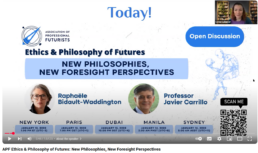
Presentation
Building on her recent chapter ‘Designing post-human futures’ in Knowledge for the Anthropocene (eds, Carrillo, J. & Koch, G.), and current exhibition/lab ‘Toward Alien Cosmologies, prospective of an anthropological reset’ in Geneva, Raphaële Bidault-Waddington will introduce the diversity of emerging philosophies that she mobilizes to open, think and structure new future perspectives.
The Anthropocene, but also the AI era and the post-truth paradigm, currently shake all our anthropological foundations, ranging from our terrestrial anchoring and (toxic) lifestyles, to anthropocentric value-systems, rationality principles and forms of consciousness. How can we design resilient future worlds, or even cosmologies, to navigate these uncertain and blurry horizons? As Professor Carrillo will highlight in the introduction, the epistemological (and ethical) challenges raised by this unprecedented planetary context require innovation in both our foresight and cognitive practices.
Presenting LIID’s on-going R&D future lab, Raphaële will highlight non-conventional philosophies, such as post-humanist philosophies (Ferrando), speculative and non-standard philosophies (Meillassoux, Laruelle) and theory-fiction (Negarestani) among others, to explore new future rationalities and methodologies.
This research also includes reflections on knowledge formats and art-based experiments. Mixing her experiences in knowledge economy, conceptual art, urban design, academic research and pedagogy, Raphaële will show how she designs hybrid future labs and heuristic devices (conceptual maps, artistic installations, fiction and image-based speculative experiences, etc.) to address the complexity and cognitive challenge of the future. Her practice resonates with current foresight explorations on world-building and transition design (Zaidi), and with futurescaping practices (Jain).
Intervention slides
Recording of the webinar on Youtube
Research axes reminder
Axis 1: Transitions & Future Worlds
Axis 2: Foresight Methodology Innovation
Axis 3: Art & Future Research
Related articles
Nothing found.
Futures Fields exhibition, HiFlow, Geneva, 2021-22
Opening future horizons, imagining new worlds
Futurescaping device and experience
Exhibition as part of the ‘Futures Fields’ season, HiFlow, Geneva, 2021-22.
'Toward Alien Cosmologies, prospective of an anthropological refoundation’, the installation exhibited at HiFlow, unfolds in a vast 360° panorama staging a profusion of images and information, selected as 'signals of the future'. The immersive and contemplative environment invited meditation on these emergences and transformations to better imagine what future worlds would be like...-
Taking up the aesthetic codes of workshops and moodboards, the installation stood as a beta version of a futurescaping device prototype, allowing to map and conceptualize future trends, and, following the modalities of polygonal research, to situate a diversity of perspectives.
–
The performative artefact also embodies a predictive algorithm trained with infinite feeds of information to build its predictions, and can be seen as a speculative design experiment...
Ci-dessous, reprise des éléments de communication de HiFlow
Pour sa nouvelle saison CHAMPS des FUTUR(S), HiFlow, lieu hybride dédié à la création, à l’innovation et au développement durable, invite la Maison d’Ailleurs de Yverdon-les-Bains, l’artiste, chercheure et prospectiviste Raphaële Bidault Waddington, et le collectif de designer Fragmentin à investir ses espaces d’exposition.
Recherche artistique et prospective
Pour sa saison Champs des Futur(s), HiFlow invite l’artiste et prospectiviste Raphaële Bidault-Waddington à exposer une vaste installation dense et immersive, qui peut être visitée pour le plaisir d’une pure pérégrination esthétique, mais qui peut aussi devenir performative à l’occasion d’ateliers. Lors de ces séances de recherche prospective et collaborative, le participant s’engage alors dans une autre qualité d’attention, découvre les arcanes de l’installation et du futurscape qu’elle dessine, et entre dans le processus du futur lab qu’elle met en scène.
‘Vers des Cosmologies Alien, prospective d’une refondation anthropologique’ se situe à la pointe des expérimentations du LIID Future Lab – plateforme de recherche développée par RBW depuis 2000 – à cet endroit même où l’art peut contribuer à l’avancée d’une recherche prospective d’avant-garde.
L’installation fait suite à une série de publications, conférences et ateliers sur les cosmologies alien réalisés par l’artiste, en France, Allemagne, USA et Suisse depuis 2017 (voir ci-dessous) et à bien d’autres travaux antérieurs sur des thèmes tels que le futur des villes, des transitions, de la globalisation, de l’économie, des technologies, de l’identité, etc.
Ouvrir les horizons futurs, imaginer de nouveaux mondes
A l’heure de l’Anthropocène, de l’IA et de la post-vérité qui secouent tous nos usages comme nos fondements anthropologiques (science, ancrage terrestre, humanisme anthropocentrique, etc.), il devient nécessaire de se forger de nouvelles visions du monde et de l’avenir, ce que les anthropologues appellent des cosmologies. Dans ces nouveaux univers qu’il reste à imaginer, l’alien est autant l’humain qui doit redéfinir ses modes de vie et d’existence, l’IA dont les boîtes noires nous échappent, le non-humain, les virus et les espèces hybrides façonnées par la bio-ingénierie, et plus généralement l’inconnu et le futur.
Comme RBW l’évoquait dans sa conférence lors de l’inauguration de HiFlow en 2020, le changement de paradigme actuel nous demande de reconstruire une relation vivante et plurielle avec le futur, pour ne céder ni aux visions apocalyptiques ni aux fausses promesses technologiques disneyifées. Ce que RBW appelle les cosmologies alien, ce sont ces mondes futurs à réinventer individuellement et collectivement, en ouvrant et libérant l’horizon futur, et en le jalonnant de repères multi-dimensionnels (notions de topologie prospective et de futurescape). Malgré la diversité, le spectre et la complexité des champs des futurs à explorer, le futur appartient à tout le monde et l’exposition est une invitation à y plonger.
Ambiance immersive et inspirante
Bien qu’ouverte de toutes parts, l’installation, avec son effet de saturation débordante et son éclairage singulier, forme une sorte d’antre immersive, de « bulle poético-spéculative » (nom d’une autre installation iconique du travail de RBW), dans laquelle le spectateur est invité à laisser flotter son regard sur les centaines d’éléments mis en scène : images issues du web évoquant le futur, documents d’analyse et bribes de récit, concepts prospectifs et diagrammes conceptuels un brin énigmatiques (conçus par l’artiste et édités en série limitée – contacter l’équipe de HiFlow pour en savoir plus). Cartographiés sur les cinq murs flottants, ces éléments forment une topologie panoramique, un monde, non sans rappeler l’esthétique et l’ambition de l’Atlas Mnémosyne de Aby Warburg qui dessinait un panorama de l’histoire humaine en une encyclopédie d’images. Mais la manière dont les éléments sont disposés et son caractère très low-tech (l’installation est ainsi 100% recyclable), laissent également penser à un travail en cours, un chantier, comme si l’on visitait un laboratoire où venait d’avoir lieu une bouillonnante séance de brainstorming… peut-être dans un think-tank de prospective, ces instituts toujours un peu mystérieux et qui travaillent souvent de manière assez artisanale… à moins qu’il ne s’agisse du cerveau de l’artiste qui nous livre son paysage mental …
Dispositif heuristique spatialisé et modèle de machine prédictive
En arrière-plan de l’expérience sensorielle, l’installation poursuit les recherches de RBW et du LIID sur les formes et la production de connaissance (heuristique) par l’art. Portée par cinq parois disjointes, l’installation reprend la figure du polygone ouvert chère à l’artiste, et par laquelle elle spatialise et croise différentes perspectives formant ainsi une topologie à 360° des enjeux prospectifs à adresser – voir son projet Polygon exposé en 2010 à la galerie Apex à New York puis reformulé de manière fictionnelle dans son livre « Paris Ars Universalis, scénario-fiction d’un futur Grand Paris »(éditions L’Harmattan, 2017), ou encore son projet Sémiospace mené à Zurich et Genève en 2014-16.
Sur chaque mur est déroulé un feed d’information pouvant être enrichi sans fin, et mettant en lumière des tendances et des indices du futur, ce que les prospectivistes appellent des « signaux faibles », sans que l’on sache exactement ce qui les définit. A mi-chemin entre innovation prospective et questionnement sur ses développements technologiques actuels, l’installation modélise à échelle humaine l’architecture d’un algorithme prédictif qui détecterait ces signaux et formulerait des visions ou scénarios futurs à partir du big data.
De part et d’autre des feeds de couleur, les matériaux de recherche et diagrammes viennent soutenir (ou programmer ?) cette analyse spéculative mobilisant autant la raison que l’imagination. Tout en restant résolument composite, chaque mur adresse une échelle de réflexion permettant une vision en écosystème, une multiplicité de point d’entrée et une diversité de raisonnement prospectifs. Les matériaux sont issus des recherches prospectives les plus avancées et sont explicités lors des ateliers.
En plus de sa dimension contemplative, l’installation peut donc également servir à se former à l’art du futur, à imaginer des scénarios et stratégies futurs pour des organisations publiques ou privées, à écrire le scénario d’un film, à concevoir un projet, un jeu vidéo, et bien d’autres choses…
Le cheminement cognitif ouvert et exploratoire vers des cosmologies alien développé par RBW fait écho aux réflexions sur les nouvelles philosophies post-humanistes (Ferrando), fictions hors-science (Meillassoux), littératie des futurs (Miller) et techniques de future design et de world-building (Zaidi) qui renouvellent actuellement l’art de la prospective.
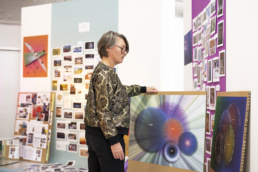
Biographie
Artiste et auteure au parcours atypique, Raphaële Bidault-Waddington voit l’art comme un vaste laboratoire de recherche formel, conceptuel et expérientiel du monde, ce qui l’a amené à développer une pratique hybride et protéiforme dans et en dehors de la sphère de l’art, notamment sur le terrain de la prospective. Son travail inclut une exploration de fond sur les images, les imaginaires et les formes de la connaissance, donnant lieu à des installations, des photo-montages, de diagrammes, des textes et des conférences.
Si sa visibilité artistique reste discrète, sa plateforme de recherche prospective LIID Future Lab expérimentent depuis 2000 de nombreuses collaborations à la croisée des sphères urbaines, économiques et académiques. LIID conçoit des futurs labs pour explorer le futur que ce soit de sa propre initiative (comme sa R&D sur les cosmologies alien), ou pour des entreprises, des villes, des universités, des think-tank et des lieux culturels en France et de nombreux pays.
Quelques références : Institut des Hautes Etudes en Science Technologies, Paris ; Grand Paris / Ville de Paris ; Urban Lab UCL, Londres ; Aalto University, Helsinki ; Tong Ji University, Shanghai ; Etisalat Academy Dubai ; Ville de Montévidéo (Uruguay) ; Fondation LUMA, Arles ; Parc de la Villette, Paris ; Groupe Galerie Lafayette ; Bouygue Immobilier et Bouygue Construction ; Peclers Future Trends, Paris ; Insitute For The Future, Palo Aalto ; GDI Future Think-tank, Zurich ; etc.
RBW est membre du New Club of Paris, un réseau d’experts internationaux en économie de l’immatériel et politique d’innovation, et du Global Foresight Network de l’Unesco.
Voir toutes ses productions artistiques et expositions sur www.rbidaultwaddington.net
Et toutes ses conférences, publications et futur labs proposés aux organisations sur www.liid.fr
Research axes reminder
Axis 1: Transitions & Future Worlds
Axis 2: Foresight Methodology Innovation
Axis 3: Art & Future Research
Related articles
Nothing found.
Art & Foresight, 24th World Future Studies Federation Conference, Berlin, 2021
Critical Thinking at the Frontier
of Art and Foresight
The Openness of Futures, 24th World Future Studies Federation (WFSF) World Conference (online program), Berlin, 2021.
Continuing from the intervention made in 2020 at the UNESCO’s Summit, this conference started with a focus on Time, a question so crucial to Art, the latter being no only a temporal marker, but also in many ways a vehicle for Time exploration and travel, whether towards the past, the present or the future.-
On the side of the future, artistic ecosystems produce a profusion of ‘signals of change’ to be read and deciphered as future insights. They also create trends and prototypes contributing to the making of the future in many areas (technologies, education, well-being, civic life, etc.). They somehow constitute a laboratory for speculative research. Here the question of the future of work was taken as an example.
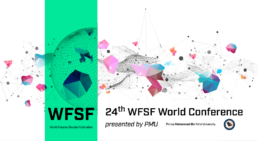
Abstract
If Art has always been a source of inspiration to Foresight, its critical frontier and contribution to Future research is still under-discussed – as opposed to Design (Candy) or Science-Fiction (Zaidi). In this communication, we will show via a rich selection of references, how contemporary art practices and critical thinking can open futures. If futurism is the explicit intention of few artistic movements in the 20th and 21st century, Art is not dedicated to the future per se.
Art operates as a non-conventional anthropological time tracker and time traveler, alongside mankind’s past, present and future. Its multicultural and non-instrumental character creates space to re-define and decolonize visions of the past, historical “truths” or past futures, provides a multi-perspective lens on the present, and lays the ground for alternative insights on the future.
Beyond their visual or affective dimensions (generally considered in foresight), Art productions can be read as weak-signals revealing societal transformations, imaginaries and trends in all domains. Since the 90’s, certain artists, curators and critics have seen Art as a critical laboratory, questioning related value-systems and philosophical frames, the very principle of interpretation and speculation, and the porous border between reality and fiction.
Exploring the depth of the aesthetic experience via Art supports the investigation of the many facets of the future, that other ambiguous fiction. Art thus complements the more performative and use-centric prism of Design on the future.
Then Art experimentation and communities can also prototype futures, incubate societal, technological or urban transformations, and shape cultural trends via their live and virtual ecosystems of influence.
Finally, more recent artistic research projects create innovative methods and trans-disciplinary and speculative rationales, which open new entries and contributions to Futures Literacy and Foresight knowledge at large. TAC Future Lab is positioned on this specific zone of artistic and foresight innovation.
RBW
Intervention slides
About The Openness of Futures, 24th WFSF World Conference
The conference theme reflects the broad dimensions and dynamics of futures studies and describes an arena in which we explore the expansiveness of our imagination – an open universe prepared to deal with the grand challenges of our time, beautifully articulated as desirable visions of sustainable progress and hope.
The Openness of Futures is an invitation to travel into a new era for futures.
In these futures you will be able to experiment with technology enhanced methods and teaching, transdisciplinary approaches to opportunity-based problem solving and new paradigms and concepts for global collaboration and societal development.
Site et programme de la conférence : wfsfconferenceberlin2021.org
Research axes reminder
Axis 1: Transitions & Future Worlds
Axis 2: Foresight Methodology Innovation
Axis 3: Art & Future Research
Related articles
Nothing found.
Designing Post-Human Futures, Knowledge for the Anthropocene, 2021
Designing Post-Human Futures
Chapter in Carrillo, J. & Koch. G. (eds), Knowledge for the Anthropocene, Edward Elgar publishing, 2021.
If the TAC Future Canvas diagram has so far been used to structure a reflection on global transitions (Anthropocene, AI, post-colonial era, etc.), and served as a 'prospective topology', this essay laid the foundations of our methodological and pluriversal research on future worlds and on what we call the horizon of alien cosmologies.-
The anthropological refoundation associated to the current paradigm shift, calls for both disruptive and interdisciplinary input and leads us toward the teachings of Francesca Ferrando’s post-humanist philosophy and methodology, that are crossed with learnings from Foresight, Anthropology, and those of LIID Future Lab (trend analysis, design of hybrid methodologies and conceptual diagrams).
Chapter abstract: The Anthropocene forces us to rethink the human condition at large, from the everyday individual gestures to shared life-styles, from productive uses to all social organizations, from development principles to atmospheric sustainability and space expansion. Simultaneously, science and technology also challenge the limits of human nature and of life, whether via bioengineering, synthetic biology, neuroscience, algorithms or the post-truth paradigm, that create a deep identity and ontological insecurity. At all scales anthropological fundamentals and certitudes are shaken and call for innovative futures and holistic cosmologies to lead human action. Learning from foresight, design, anthropology, science-fiction and post-human studies, this article introduces “Toward Alien Cosmologies”, a conceptual canvas and critical topology to envision future horizons, guide the co-design of post-human future worlds, and facilitate futures literacy and empowerment.
Keywords: Anthropocene, Design, Foresight, Post-human Studies, Anthropology, World-Building, Futures Literacy.
About ‘Knowledge For the Anthropocene’
Human-induced environmental impacts are bound to disrupt our way of life in deeper ways and at wider scale than anything previously experienced by mankind. Global existential risks challenge the conditions of the Biosphere that prevailed through the Holocene, the geological epoch that saw human civilizations flourish. However, the current knowledge base seems inadequate to help us cope with such realities. What relevant knowledge will become critical to deal with deteriorating environmental conditions? How can science, technology, innovation and education be radically transformed for adequately responding? How can societies and governments continue to function? How need our mind-frames evolve? These and other related questions are addressed in a simple and direct manner by a set of international specialists. The common purpose is to provide a general perspective on the role that knowledge –the most important leverage to human action, may need to play in the unfolding circumstances of the Anthropocene.
1 - The Anthropocene, A Post-Humanist Future Challenge
The concept of Anthropocene epitomizes a period of history where the actions of mankind on Earth have reached the point of modifying its ecosystems, atmosphere and life conditions, creating an era similar to a geological era, no matter where its precise starting point is. The Anthropocene is a critical anthropological paradigm marking that core planetary evolution turn, asking mankind to be aware of and responsible for its impact, and calling for a civilizational transformation toward resilient uses and ways of living. The Anthropocene is both a critical wake-up call and an impulsion to redesign the life conditions on earth. Humanity needs to emancipate from anthropocentric and predatory economies, policies and lifestyles, most of which are rooted in the western humanist, progressive, liberal and modernist value system.
These conceptual frames gave full license to men’s freedom to innovate in all matters and have shaped most of globalization standards. For that reason, the future is bound to be “post-humanist” and we paradoxically need to invent it, which means redefining the way we project ourselves toward the future, create and lead a sustainable and “future-proof” change. The earthquake of the COVID-19 pandemic and the radical adaptation of the entire humanity has shown how systemic change is possible and has started prototyping what could be the “new normal,” somehow paving the way for a now urgent environmental transition. It is time to act and eventually enforce futures, not just predict and anticipate them as an outside performance we would watch. Whether we like it or not, we are inevitably included in the picture.
In order to explore and design Anthropocene futures and to open alternative perspectives to the collapse narratives, we cannot keep the same strategic tools and foresight methods, most of them being also rooted in western modernity and cognitive frames.
Imagination is a resource that needs to be mobilized to open the future horizon and engage in it. The Anthropocene forces us to rethink and reinvent the human condition at large, from the everyday gestures to shared lifestyles, from all social organizations to the atmospheric sustainability and space expansion. The paradigm shift touches on the cosmological order, as it touches on humanity’s visions of the world, its place in the universe, and its relation to knowledge, truth, existence, space and time, whether past, present or future.
Simultaneously, science, technology and the digital transition at large also challenge the limits and definition of human nature and societies, calling for an anthropological redefinition and leading to innovative post-human philosophies. Bioengineering, synthetic biology, neuroscience, AI and deep fakes bring profound ontological issues and uncertainties, making human-beings as alien as other natural and artificial species, on a planet where the natural co-living contract seems broken. “We have become viruses for the planet” (Descola, 2020) says the iconic anthropologist during the COVID-19 crisis.
Digital humanities research shows the impact of technologies on every aspect of life from work to intimate life and health, from economy to urban life, from education to community building and democracy. The information overload and the data deluge (Anderson, 2008) have entailed the post-truth paradigm and created a multiverse effect where reality becomes far more ambiguous and versatile.
Resulting from a mix of these multi-dimensional, multi-scalar and entangled transitions, the future will be both post-humanist and post-human. It however remains an absolutely complex challenge to address and design these holistic futures and bigger pictures, requiring cognitive and methodological innovations. Although various disciplines are anticipating, formulating or programming futures, the future remains an art and a fiction that cannot be demonstrated.
The future is an evolving frontier to explore with imagination, knowledge and experimentation. For this purpose, this chapter will introduce a still imperfect cognitive guidance tool, called Toward Alien Cosmologies, to be read as a methodological prototype to design possible post-human futures.
2 - Design Of A Post-Human Foresight Methodology
In her essay “Toward a post-humanist methodology, a statement” (Ferrando, 2012), philosopher Francesca Ferrando calls for an emancipation from western essentialism, anthropocentrism, biocentrism and rationale to address the post-human and post-colonial paradigm.
She writes: “Post-humanism has to acknowledge the whole human experience in order to be receptive to the non-human and be open to unknown possibilities” (op. cit., p. 17). And “According to cosmology, the universe is expanding at an accelerating rate” (ibid., p. 11). Also:
“A post-humanist methodology should not be sustained by exclusive traditions of thought. It should be dynamic and shifting, engaging in pluralistic epistemological accounts, not in order to comply with external requirements of political correctness, but to pursue less partial and more extensive perspectives, in tune with a post-human future which will radically challenge human comprehension. (ibid., p 17)”
The future guidance cognitive tool presented in this chapter, is meant to support the exploration of these plural and somehow floating and versatile perspectives.
But Toward Alien Cosmologies is also informed by more pragmatic, strategic foresight and design-oriented perspectives to remain connected to earthly realities and support resilient action for the Anthropocene.
From the field of foresight, we want to draw upon its methodologies and forward-looking cognitive resources, such as systemic and morphological analysis, horizon scanning and building, or scenario-planning, each allowing to address a certain level of complexity, build future perspectives or show future potentials. But on the other hand, it is important to keep in mind that the discipline itself was created after the Second World War, mostly to guide both corporate investments and public policies (such as industrial programs, energy and mobility infrastructures planning, etc.), which was certainly not neutral in regard to the rise of the Anthropocene and human impact on the planet.
Although some new voices and more hybrid approaches currently arise – as we will show with design, anthropology, or science-fiction, and attempt to do in this chapter – the foresight discipline and community remains today very western, masculine and geared toward strategic purpose.
On the contrary, weak-signals research, that is, the detection of emerging signs (information, scientific discovery technology, project, representation, concept, etc.) considered as indicators of the future, meant to become change drivers and form trends, is an under-valued foresight practice that we will favor. Although quite intuitive and subjective, its diversity, openness, accessibility and collaborative dimensions make it especially inclusive, empowering and efficient, if done thoroughly and in-depth. The collection of weak signals leads to the design of trends as an evolutive map.
Following Ferrando, the foresight approach developed in this chapter offers a multi-scalar and multi-perspectives canvas (from the microbiome to the cosmos), where a rich ecosystem of trends can be highlighted as a kind of borderless climate rather than an instrumental and framed system. The resulting live future panoramas will show micro and mega trends emerging from weak signals detected with a 360°, post-colonial, and non-hierarchical approach. For instance, a designer’s creative experiment can be associated with an important academic publication or with a film to highlight and articulate a trend.
From the field of design, an acknowledgement of the pragmatic power of design to translate creative ideas into new uses and innovations and somehow “make the future” is necessary. Design is an engine to prototype and install resilient uses and ultimately change lifestyles. Its use- and human-centric pragmatism shows however some limits in regards to the Anthropocene and post-human paradigm. Design requires more pluralism, broader lifestyle and eco-systemic perspectives to better include impact concerns in its process.
It also needs a deeper ontological, anthropological and cultural questioning beyond its pragmatic endeavor. In that regard, art productions, which reveal cultural imaginaries and values, will be complementary weak signals. Combining pragmatism, imagination and criticality enables finding relevant weak signals at the new frontiers of the design discipline addressing these issues such as in critical design, speculative design, fiction design, instance design, and the emerging and future-oriented design anthropology (Smith et al., 2016; Pink & Salazar, 2017).
This latest promising discipline is also highly relevant to bring forth new understanding of human existential relation to the future, a topic we will address again in the conclusion. These emerging disciplines help get a perspective on how the future is being used whether by foresight and design professionals, or by businesses, institutions, politicians, cultural and spiritual leaders. The contribution of anthropology to the Anthropocene foresight and design research should, however, include a critical awareness of its conceptual and historical fundamentals, which are rooted in western colonial times with the depiction of “other” and past cultures. Now the other, the alien, is us all in the future.
A common challenge and new frontier to both design (Bonnet et al., 2019) and foresight, is the need to redesign holistic worldviews, value systems and meta-narratives (cosmologies emancipated from classic western anthropological frames) in and of the Anthropocene era. Both disciplines are currently renewing their interest in science fiction (Zaidi, 2019), which has more traditionally been creating rich and complex future worlds, and now serves as a future world-building approach.
Although they result in vibrant narratives giving an emotionally rich sense of possible futures, world-building methodologies tend, however, to create closed worlds as in video games, novels or films and still require methodological innovation. Science-Fiction and world-building do not show and discuss their underlying systems. Referring to SF authors Gibson and Delaney who coined that concept, Zaidi recalls that SF eventually allows for a reflection on implicit cultural superstructures.
She explains: “by engaging with alternative future worlds, science fiction readers develop an understanding of the modular, foundational components of a culture. They build their capacity to engage with alternative systems and ways of living” (Zaidi, 2019, p. 21).
Following both Ferrando and Zaidi, the post-human Anthropocene paradigm requires to design open and dynamic future multiverse and cosmologies, allowing for a diversity of co-existing worlds, lifestyles, value-systems and meta-narratives, existing both in the tangible and informational reality. As a critical topology and canvas, Toward Alien Cosmology is meant to help design, question, realize or clarify, both world-building and cultural super-structures. It is a dual and imperfect future world-building and -unbuilding cognitive tool that doesn’t claim any sense of truth.
LIID Future Lab Experiences and Conceptual Tools
Taking into account these insights from post-human, foresight, design, anthropology and science-fiction studies, I will now introduce the latest prototype (Bidault-Waddington, 2020a, 2020b, 2020c) of the conceptual matrix used at LIID Future Lab to investigate and design post-human futures, as open and holistic cognitive spaces to support both imagination and action.
Toward Alien Cosmologies (V6) works as a fluid methodological canvas to guide the design of creative future projections at multiple scales and horizons, still giving it a knowledge-intensive solid support and a plural and multi-purpose orientation. In that regard, the conceptual model capitalizes on twenty years of future research and eco-systemic change analysis carried by LIID at the crossroads of art, economy, urban design, academia, digital humanities and foresight.
Since its inception in 2000, LIID has designed and experienced future lab methodologies to explore the future, which, among other formats (texts, images, conferences, workshops, art installations), include the design of heuristic tools and diagrams, such as a creative conceptual canvas to, for instance, envision the future of large-scale metropolis (Bidault-Waddington, 2012).
A diagram synthesizes a cognitive architecture, which helps to mentally spatialize, cross and interrelate a wide scope of critical topics or possible facets – a polygonal semiospace in LIID’s vocabulary (Bidault-Waddington & Menetrey, 2016) – still remaining open and borderless, with no specific beginning or end (vs narratives or scenarios). Often used in foresight methods, conceptual diagrams are efficient foresight guidance tools as they facilitate shared mental representations, collaborative research, inclusive pedagogy, future empowerment and the design of inspirational projects and scenarios.
Toward Alien Cosmologies (V6) also takes into account how the mind needs to make simplifications to organize reasoning around complex issues, to produce and ground a sense of understanding, if not a certitude. It is one of the challenges to address the Anthropocene cosmological paradigm. As a reflexive tool, the canvas also helps become aware and clarify tacit cultural superstructures and value-systems. And on a more pragmatic level, the conceptual matrix also serves as a classifier of information, research material and weak signals, to then draw and map trends, as we will now experience (see Figure 21.1).
Toward Alien Cosmologies / TAC Future Canvas V4, © Raphaële Bidault-Waddington, 2020.
3 - Toward Alien Cosmologies, A Criticalfuture Topology (V6)
The Toward Alien Cosmologies conceptual matrix is designed as a critical future topology visually organized as four floating spheres used to map weak signals at four different scales, but with no specific order or hierarchy. Each sphere is border-less like a cloud, interweaves and collides with the others, but still carries specific critical topics, vocabulary and perspectives.
With this blurry conceptual canvas, weak signals, information, and ideas of all kinds can be mapped in a large and open panorama, the vagueness leaving space for infinite appropriation and adaptation. From these weak signals, it becomes possible to highlight future trends, a full diversity of macro and micro trends, within and across spheres as virtual constellations to be drawn. Trends and weak signals give insights of future potentials, still leaving space for speculation and imagination. To give an example, below are presented for each sphere, key critical topics, a selection of weak signals and pivotal trends that should be continuously enriched and updated.
Then each user can design all-inclusive future cosmologies as large-scale, dynamic and open cognitive panorama where to draw a diversity of inspirational scenarios giving them texture and somehow staging them. With its four spheres, the canvas obliges users to expand from their own mindset and bubble and consider all dimensions and perspectives rather than staying in limited frames (whether the one of design, foresight or any domain).
With its title and distinctive semantic, Toward Alien Cosmologies is also meant to be thought provoking from the first instant to stimulate, liberate and empower. To feed that impulse, the four spheres are called “Mysterious machine”; “Life-Style Design”; “Multi-dimensional ecosystems”; and “Bigger Picture.”
As Ferrando suggests, “A post-humanist methodology has to be adaptable and sensitive; it has to indulge in its own semiotics, hermeneutics, pragmatics, meta-linguistics, in order to be aware of the possible consequences which they might enact on a political, social, cultural, ecological level” (Ferrando, 2012, p. 11). The blurriness should paradoxically create a new form of clarity where everyone can somehow “see” at different levels and in different ways but still keeping a shared canvas, allowing to feel, give and make sense, but also imagine, speculate and project toward the future. We are now going to take a journey into each of the spheres to apprehend their critical topology with a selection of weak signals.
As the reader of this chapter will experience it, and that should be the demonstration made live, it will give a new clarity and more sense to the complexity of the future of the Anthropocene, and to the critical topics already expressed in this chapter.
Mysterious Machines, New Being and Ontologies: Bodily and Cognitive Diversity
In this first cloud, we want to take full awareness and explore the current ontological uncertainty and insecurity human beings have in front of themselves and in front of new material and cognitive entities such as AIs, all reaching the status of aliens, as foreign and not fully knowable or controllable beings. Whether organic, viral, informational or technological, new families of fluid species are emerging, transforming and taking part in the extended post-human Anthropocene society.
Are we viruses? as Descola suggests or Are we humans? are asking curators Beatriz Colomina and Mark Wigley at the Istanbul Design Biennale in 2017 (Colomina & Wigley, 2019), showing how humanity has historically been shaped by design. Or else are we becoming humax, that is, humans maximizing themselves to better sustain in the future (whether augmented or not)? as design researcher Tony Fry explores in his referential book Becoming Human by Design (Fry, 2012). Even gender distinction seems to become unclear with transgender realities showing how ambiguous the genetic expression and mutable body functions can be.
Along with the augmented and bio-engineered bionic body, which tends to add capabilities to the human body (e.g., sportsman Victor Pistorius), the Cyborg foundation created by artists Neil Harbisson and Moon Ribas, shows how humans can hack their own body to add sensorial aptitudes. Whether intentionally or not, and via any form of cultural influence, it is now clear that human sensorial, emotional and creative mechanisms can be manipulated, as part of the design of subjective “bubbles,” broader attention ecology (Citton, 2014) and transduction process (Simondon, 1989).
Continuing on the cognitive side, even though neurosciences now allow men to intervene on the brain and the mind, these remain mostly terra incognita. Following prominent philosopher Catherine Malabou, even the human freewill, consciousness and creative autonomy are questioned, as the brain seems to have its own automatism (Malabou, 2017), a thesis also defended by Yval-Noah Harari in his influential book Homo Deus, a Brief History of the Future (Harari, 2016).
Beyond the human live experience, similar ontological questions touch the animal and vegetal realms, raising broad ethical and legal issues (topics to be furthered in the three other spheres). Same issues arise from AIs, these “mysterious machines” as MIT Technology Review called them on its May 2017 cover page, or new generation of synthetic biology beings such as self-healing xeno-bots designed by the University of Vermont (Brown, 2020), bots or deep-fakes, these quasi-personas we interact with online. The hypothesis of the emergence of a Singularity (Kurzweil) is also on this critical topos. So is the status of viruses such as COVID-19 that humanity seems to have silently given the right to stop its planetary activity. Who or what instances are entitled to tackle or lead the Anthropocene?
To redefine the diversity of modes of existence on earth and beyond, we suggest, from the perspective of this first sphere, to revisit this extended family of being and agents under the fundamental prism of the bodily and cognitive diversity to help us create a sense of ontological order. The implicit anthropological core-trend in this sphere is the convergence between the organic, the cognitive and technological species. Another one is the declining possibility of a clear “discontinuity” (cognitive and/or bodily separation) among this diversity, only degrees and potentials for differentiation, versatility, ubiquity, autonomy, agency and resilience.
Lifestyle Design and Cultural Reset: Relational, Collaborative and Spatial Diversity
In this second sphere of future critical topics, we want to zoom in on the design of uses, and how they transform and shape the lifestyles of tomorrow: food, agriculture, production, work, business, innovation, education, art, culture, sport, leisure, care, health, sexuality, love, religion, dating, hospitality, mobility, urbanity, and so on are the domains of uses that we want to analyze without separating them in silos as we see how again, the historical anthropological categories are evolving and hybridizing.
What is work when a passive leisure practice of watching a film for free generates value in a firm? What are equitable co-working conditions between humans and AIs? is another question already and seriously raised by the workers syndicate TCO in Sweden.
What new form of relation, collaboration and sentiment do we develop with caring smart co-bots as with animals? How is it that people fall in love with sexbots? Can a supposedly “useless” art experiment be a resilient production for the Anthropocene?
What is the permaeconomics (Bidault-Waddington, 2018) of third places where expenses simultaneously become productive in another repertoire of use?
Many shifts among these repertoires are in progress, such as, to give a very concrete example, the current massive repositioning of hotel rooms into day-work spaces. In this regard, design, anthropology and innovation are pivotal disciplines to capture the weak signals and pragmatic prototypes of possible futures.
Instead of a simple focus on uses, this sphere offers the possibility of experiencing how cultural lifestyles are transforming with and for the Anthropocene, and of (mentally) staging them in digital and physical space as live pictures including characters.
The transformation of social uses goes along a transformation of related value(s) and utility, a concept at the heart of the whole societal organization and economy. How relevant is it to travel when the associated emotion is not pleasure or efficiency anymore but a sense of pollution? Where and what are the new forms of value creation around resilient uses and impacts? What are the new loops of local uses and circular economies? The Anthropocene includes new value(s) systems and symbolic economies that will guide the transformation of capitalism in the future, as we see for instance with the Tech For Good innovation movement.
At the heart of these social uses’ transformation, we want to capture via weak signals how innovative cultural uses can be absorbed, such as via educational processes and co-learning mechanisms, whether happening in schools, online, in cultural places, incubators, community centers, or any peer-to-peer interface. The learning dynamics are going to be leading the shift toward resilient lifestyles.
Behind this pragmatic focus on societal uses, utility and resilience, we should also apprehend in this sphere, the explicit and implicit hierarchies and subordination mechanisms operating in concrete uses and lifestyles.
AI research, post-colonial studies and feminism are useful filters to debunk power structures encrypted in inherited anthropological frames and categories (e.g., the economy of educational, domestic and care work) to restore equity in the future.
Multi-dimensional Ecosystems: Mapping Planetary Impact Chains
As said in the introduction, resilient innovation for the post-human Anthropocene cannot be approached solely with a focus on experiential social uses and lifestyles. It should include systemic and eco-systemic perspectives to acknowledge chains of positive and negative impacts at a planetary level.
Since these chains are borderless and so is the realm of information, there is no point in choosing intermediary scales as frames of analysis. This does not prevent from programming systemic change at a narrower scale such as the one of cities or bioregions, but it has to be with full concern for extended planetary impact chains. So, in this third critical sphere, the tool should help to capture the large scales and systemic transformations (agriculture and natural resources, mobility, energy, economy, academia, cultural soft-power, public bodies, legal frames), and, as for the sphere of uses, keep them entangled, as hybridization is also a key movement of transformation.
Global resilience will come from a smart adaptation of the material, social and informational ecosystems, and, as the Green New Deal (Rifkins, 2019) prescribes it, infrastructures will be pivotal to implement an Anthropocene sustainable ecology. A core future trend is (again) in the hybridization of infrastructures and especially energy, mobility and data infrastructures.
Then the question is: what level of man-made geo-engineering and space occupancy is acceptable and truly resilient? Emerging digital infrastructures such as the Gaia X recently launched by the EU, or the OneWeb satellite infrastructure carried by SpaceX, show how the data-ecosystems are at the center of the global equation with attempts to recreate autonomous continents to protect sovereignty. They even take a lead on energy and transportation infrastructures, as they tend to capture users’ interfaces. The polemic around TikTok and Huawei is at the heart of this new global equation.
The post-truth paradigm, democracy and science crisis are also part of this eco-systemic vulnerability. Another eco-systemic future trend is around the legal and accounting frames’ transformations for the Anthropocene, which will impact political, economic and academic systems, and large parts of human activity on Earth. The World Economic Forum is now calling for a Great Reset of global capitalism and a deep metamorphosis is on its way, with new value, purpose and truth regimes to be designed for an Anthropocene oriented global equity (both as equitable and as shared capital).
How can we design and operate the material and immaterial global commons? How to mobilize global collective intelligence to redefine our shared life conditions on the planet? How to design relevant instances to represent all stakeholders (humans, non-humans, organizations) properly?
Or can we imagine a fair post-human algorithmic democracy? These matters touch on our core societal, existential and cosmological value-systems and the fourth sphere will allow us to open a more in-depth critical space for this purpose. But in this sphere, we want to remain close to change and adaptation capacities, and foresight research will still be very relevant here.
Finally, another strong future trend to be highlighted in this eco-systemic and entangled sphere is around de-mobility, a concept becoming a solid reality and an accelerated transformation mechanism with the COVID-19 crisis. How to pragmatically reshape our global ecosystem around that pivotal idea of a dramatic reduction of mobility? What are our urbanities, community cultures and territorial integration when most activities go online? What has become the Global Village, when business, leisure and educational tourism stop or go virtual?
Bigger Picture: Meta-narratives, Cultural Superstructures and Art of the Future
In this last sphere that will also serve as a conclusion toward alien cosmologies, we want to take another more holistic perspective and explore the richness of anthropological and future meta-narratives that help human beings to give meaning to the life experience on Earth. Behind any rationale lie belief and value systems but also stories and emotional drives (such as fear and hope) that shape mankind’s relation to existence and to the world (cosmologies).
If historically religions have been the holistic frames to give meaning to life or if western science has tried to rationalize it, many other meta-narratives are emerging, such as the Anthropocene itself. This last sphere allows analyzing the mechanisms and cultural superstructures behind the new meta-narratives such as Ray Kurzweil’s Singularity messianic scenario, or James Lovelock’s Novocene (Lovelock, 2019), which furthers his Gaia theory and stages algorithmic beings.
Then, why do creative theories, such as Afro futurism seem to address so well the hopes of new generations? What could be new cosmovisions and pluriverse inspired by native American holistic cosmologies (Escobar, 2017), or speculative extro-science fiction (Meillassoux, 2015), that is, structured but borderless meta-narratives that include what science has not rationalized in its frame? With a focus on possible bigger pictures, this sphere is meant to feed the more pragmatic rationale of the two previous spheres, expand them to non-earthly and more paradoxical or invisible realities, whether in their imaginary, philosophical or quantic dimensions. Ultimately, this last sphere rebuilds a bridge with the first ontological sphere.
As Ferrando recommends (2012, p. 11), we want to indulge in creativity and hermeneutic potentials, to oblige us to a proper critical thinking and as a safety-gate to keep the Anthropocene and the future open, diverse and impossible to fully master.
The future belongs to everyone and the critical topology here presented is meant to design multiple future perspectives and empower everyone to resist to the way the future (and the Anthropocene) is also becoming an instrument of power. The ecology and economy of fear, is a key emotion driving the future, currently challenging the ecology of free desire (libidinal economy), which has prevailed in liberal times. Fear is a biological process deeply nested in the human body, mind and life condition. In 1929, Heidegger marked a turn toward modern existential philosophy by introducing the limit and fear of death in metaphysics heritage. The Anthropocene turn is marked by the fear of the planet’s destruction and more generally of the future, as pivotal life reconditioning forces. The Anthropocene is shifting our minds toward the future and obliges us to be future-conscious, as a new form of consciousness not centered on the bubble of the ego, but on multiple spheres.
With this in mind, Toward Alien Cosmologies stands as a cognitive and pedagogical tool to support humanity’s Futures Literacy (Miller, 2018), an emerging bottom-up foresight approach promoted by UNESCO, as much as a contribution to the resetting of the anthropology discipline toward the future.
Whatever foresight methodology or predictive technologies we might have, the future is not written and will remain a fiction. But addressing and cultivating a creative relation to the future at all scales, is what can bring meaning and help overcome fear. It provides a paradoxical sense of clarity and a form of emancipatory inner trust rather than certitude, something we generally call hope, ultimately comforting mankind in its most singular, intelligent and imaginative capacity.
Raphaële Bidault-Waddington
REFERENCES
Anderson, C. (2008). The End of Theory: The Data Deluge Makes the Scientific Method Obsolete, Wired Magazine, June 2008.
Bidault-Waddington, R. (2020a). Toward Alien Cosmologies, AI and the Human Frontier (V3), Susch Muzeum Magazine #1.
Bidault-Waddington, R. (2020b). Toward Alien Cosmologies (V4), Prototyping a Future Conceptual Canvas of the AI Era [conference presentation], “Prototyping Futures” Winter Symposium, Study Circle “Cybioses: Shaping Human-Technology Future,” Nordic Summer University, Diffract, Berlin, March 12‒14, 2020.
Bidault-Waddington, R. (2020c). Vers des Cosmologies Alien, Topologie Prospective d’une Refondation Anthropologique (V5), FuturHebdo Anthologies Prospectives #4.
Bidault-Waddington, R. (2018). The Rising City, the New Frontier of Social and Urban Innovation, future trend report (in French), Peclers Paris.
Bidault-Waddington, R. and Menetrey S. (2016). Semiospace, a Spaced-Out Artistic Experiment, Clinamen publishing, Geneva.
Bidault-Waddington, R. (2012). Paris Galaxy Inc., a Conceptual Model and Holistic Strategy Toward Envisioning Urban Development, Parsons Journal for Information Mapping, 4, no. 1.
Bonnet, E., Landivar, D., Monnin, A. and Allard, L. (2019). Le Design, une cosmologie sans monde face à l’Anthropocène, Science du Design, 10 (2): 97‒104.
Brown, J.E. (2020). Team Builds the First Living Robots, University of Vermont, uvm.edu, retrieved on December 14, 2020. https://www.uvm.edu/uvmnews/news/ team-builds -first -living -robots
Citton, Y. (2014). Pour une Ecologie de l’Attention, Le Seuil, 2014.
Colomina, B. and Wigley, M. (2019). Are We Human? Notes on an Archaeology of Design, Lars Mueller Publishing.
Descola, P. (2020). Nous Sommes Devenus des Virus pour la Planète, interview in Le Monde, May 20.
Escobar, A. (2017). Design for the Pluriverse, Radical Interdependent, Autonomy and the Making of Worlds, Duke University Press.
Ferrando, F. (2012). Toward a Post-Humanist Methodology, a Statement, Frame, Journal for Literary Studies, Issue “Narrating Posthumanism” 25 no. 1 (May 2012): 9‒18, Utrecht University.
Fry, T. (2012). Becoming Human by Design, Berg Publishers.
Harari, Y-N. (2016). Homo Deus, a Brief History of the Future, Harvill Secker Publishing.
Lovelock, J. (2019). Novacene, the Coming Age of Hyperintelligence, Allen Lane Publishing.
Malabou, C. (2017). Métamorphose de l’Intelligence, que faire de leur cerveau bleu ? Presses Universitaires de France.
Meillassoux, Q. (2015). Science Fiction and Extro-Science Fiction, Univocal Publishing.
MIT Technology Review, Issue May 2017.
Miller, R. (2018). Transforming the Future: Anticipation in the 21st Century, UNESCO and Routledge.
Pink, S. and Salazar, J-F. (2017). Anthropologies and Futures: Setting the Agenda, in Salazar, J-F., Pink, S., Irving, A. and Sjöberg, J. (eds), Anthropologies and Futures, Researching Emerging and Uncertain Worlds, Bloomsbury Academic Press (pp. 3‒22).
Rifkins, J. (2019). The Green New Deal: Why the Fossil Fuel Civilization Will Collapse by 2028, and the Bold Economic Plan to Save Life on Earth, St Martin’s Press.
Simondon, G. (1989‒2007). L’individuation psychique et collective, Editions Aubier.
Smith, R.C., Vangkilde, K.T., Kjærsgaard, M.G., Otto, T., Halse, J. and Binder, T. (eds) (2016). Design Anthropological Futures, Bloomsbury Academic Press.
Zaidi, L. (2019). Worldbuilding in Science Fiction, Foresight, and Design, Journal of Futures Studies, June 2019, 23(4): 15–26.
Research axes reminder
Axis 1: Transitions & Future Worlds
Axis 2: Foresight Methodology Innovation
Axis 3: Art & Future Research
Related articles
Art, Innovation and Foresight Day, Louvre Lens Valley, 2024
Dedicated to the Louvre Lens innovation ecosystem, this ‘future lab’ day included three masterclasses on future and…
Art x Futures, 'Blended Futures' Foresight Journal panel, UNESCO FL Summit, 2020
Art x Futures
Speculative bubbles and expanding horizons
in “Blended Futures”, Foresight Journal panel, UNESCO Future Literacies Summit, 2020.
This intervention was an opportunity to begin formalizing reflections on how Art (the Arts) and artistic research contribute to the future and to future research (Axis 3).-
Drawing on a large palette of international references, the presentation builds on how artistic productions have constituted, since the dawn of time, anthropological and temporal markers, and should be seen as vehicle for temporal exploration, in all its possible dimensions and directions (a subject we will deepen - see related articles).
-
Artistic productions and ecosystems do have, in many ways, an agency on the future: signs of the future, ecosystems of influence, nudges and prototypes, communities contributing to innovation and change, or even spaces for new pedagogy and speculative research, are some first tracks...

A propos du Sommet de l’UNESCO et du panel
En décembre 2020, l’UNESCO organise un sommet international dédié à la prospective et à la Littéracie des Futurs’’ intégralement en ligne avec de nombreux acteurs de la prospective (dont LIID Future Lab) invités à présenter leurs travaux sous la forme de stands virtuels et à proposer des événements en ligne.
A cette occasion, le Foresight Journal organise différents panels dont “Blended Futures #1: Learning from Art, Design, Urban Design, Science-Fiction & Algorithmics to renew foresight practices” auquel prend part Raphaële Bidault-Waddington, parmi d’autres événements.
‘Blended Futures: Learning from Art, Design, Urban Design, Science-Fiction & Algorithmics to renew foresight practices’, an Open-lab session organized by the Foresight Journal at UNESCO Future Literacies Summit, December, 11th at 2pm (CET)
Video https://www.youtube.com/watch?v=at0gq7etLJs
The Future Literacies Summit is an invitation to open and renew foresight methodologies, to make them more accessible, agile and engaging, or else more critical, disruptive and impactful. In that regard, the foresight community could learn and better integrate in its methods, insights coming from other disciplines addressing the future from different perspectives and vocabularies.
In this exploratory session, the Foresight journal will invite unconventional foresight experts to share and discuss the specific inputs from art, design, urbanism, science fiction and algorithmics domains.
Host: Ozcan Saritas, Editor of Foresight Journal
Guests: Raphaële Bidault-Waddington (LIID Future Lab, France), Jean-Paul Pinto (Univ. of the Valley, Colombia), Dan Hill (Vinnova, Sweden), Maggie Greyson (Designer & Futurist, Canada), and Masaru Yarime (Univ. of Science & Technology, Hong Kong)
Intervention slides
Research axes reminder
Axis 1: Transitions & Future Worlds
Axis 2: Foresight Methodology Innovation
Axis 3: Art & Future Research
Related articles
Nothing found.
